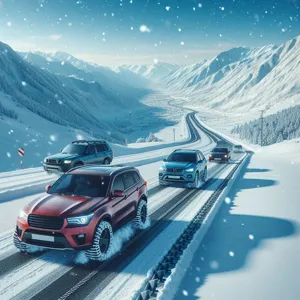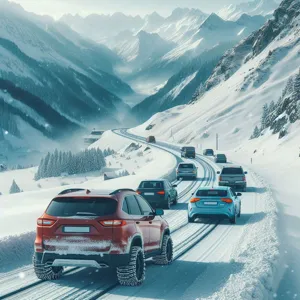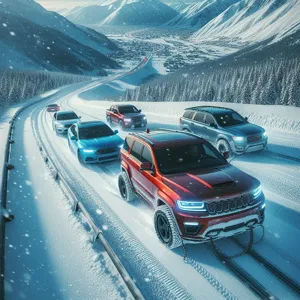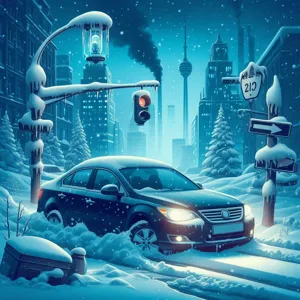As winter descends and blankets the landscape in a shimmering layer of snow, the thrill of driving turns into a daunting challenge for many.
Navigating snowy roads requires not just skill, but the right vehicle that can handle the icy conditions while ensuring safety and comfort. Whether you’re commuting to work, embarking on a ski trip, or simply maneuvering through your neighborhood, having a car that conquers the winter elements can make all the difference. In this blog post, we’ll explore the top 10 cars designed with advanced technology, all-wheel drive capabilities, and rugged performance to tackle snowy terrains with confidence. From SUVs built for adventure to sedans that blend style with functionality, get ready to discover the ultimate winter warriors that will keep you on the move, no matter how heavy the snowfall.
1. Introduction: The Importance of Choosing the Right Car for Snowy Conditions

When winter arrives and blankets the world in a shimmering layer of snow, not all vehicles are equipped to conquer the challenges that come with icy roads and harsh weather. Selecting the right car for snowy conditions is paramount, as it can make the difference between a smooth, safe journey and a treacherous, anxiety-filled drive. The importance of this choice extends beyond mere convenience; it can significantly impact your safety, comfort, and overall driving experience during the colder months.
Driving in snowy conditions requires a vehicle that can provide excellent traction, stability, and control. Snow can disguise hazards like potholes and ice patches, making it crucial to have a car that responds predictably and reliably. Features such as all-wheel drive (AWD), advanced traction control systems, and robust winter tires are essential for navigating through snow-covered streets and winding mountain passes alike. Additionally, a vehicle with a good ground clearance can prevent getting stuck in deep snow, while strong braking systems can enhance safety on slippery surfaces.
Moreover, the right car can enhance your confidence behind the wheel. Knowing that your vehicle is reliable in challenging conditions allows you to focus on the road ahead rather than worry about slipping or losing control. As we delve into our list of the top 10 cars that conquer snowy roads with ease, we’ll highlight models that blend performance, safety, and comfort to ensure you’re well-prepared for whatever winter throws your way. Whether you’re commuting to work, embarking on a family road trip, or simply navigating daily errands, the right choice can transform your winter driving experience from daunting to delightful.
2. Key Features to Look for in Snow-Ready Vehicles
When it comes to navigating the treacherous conditions of snowy roads, not all vehicles are created equal. Choosing the right snow-ready car involves a keen eye for specific features that enhance performance, safety, and comfort in cold weather. Here are the key features you should prioritize to ensure you’re well-equipped for winter driving.
**All-Wheel Drive (AWD) or Four-Wheel Drive (4WD):** The first thing to consider is the drivetrain. AWD and 4WD systems provide power to all four wheels, effectively maximizing traction on slippery surfaces. This enhances stability and control, allowing you to tackle snow-covered hills and icy patches with confidence. Look for vehicles with intelligent AWD systems that can automatically adjust power distribution as conditions change.
**Winter Tires Compatibility:** While many vehicles can be fitted with winter tires, some are designed with tire clearance and suspension systems that better accommodate them. Winter tires are crucial for improving grip in snow and ice, so choosing a car that easily supports their installation can make a significant difference in your driving experience.
**Ground Clearance:** A higher ground clearance is vital for navigating deep snow without getting stuck. Vehicles with low profiles can easily become bogged down in winter conditions. Look for SUVs and crossovers that provide ample clearance to glide over snowdrifts and uneven terrain.
**Advanced Traction Control Systems:** Modern vehicles often come equipped with advanced traction control systems that help prevent wheel spin and maintain grip on slick surfaces. Features such as electronic stability control (ESC) and anti-lock braking systems (ABS) work in tandem to enhance your vehicle’s performance in challenging conditions.
**Heated Features:** Cold weather can make driving uncomfortable, so consider vehicles that offer heated seats, steering wheels, and even heated mirrors. These features not only provide comfort but also help improve visibility and control during frigid temperatures.
**Defogging and Defrosting Systems:** Visibility is paramount in snowy conditions. Look for cars equipped with effective defogging and defrosting systems for both the front and rear windows. This ensures you can see clearly as you navigate through snowstorms, reducing the risk of accidents.
**Robust Battery and Engine Performance:** Cold weather can take a toll on battery life and engine performance. Vehicles designed for winter driving often feature batteries that can withstand extreme temperatures and engines that perform reliably even in frigid conditions. Consider models with turbocharged engines, as they can provide extra torque for better handling on slippery roads.
By prioritizing these key features when selecting a snow-ready vehicle, you can ensure a safer, more enjoyable driving experience throughout the winter months. With the right car at your disposal, conquering snowy roads becomes not just possible, but an adventure waiting to unfold.
3. Criteria for Ranking: Performance, Safety, and Comfort

When it comes to selecting the top cars that can tackle snowy roads with ease, three pivotal criteria come into play: performance, safety, and comfort. Each of these elements plays a crucial role in ensuring that drivers can navigate treacherous winter conditions with confidence and peace of mind.
**Performance** is the first and foremost requirement. A vehicle’s ability to handle slippery surfaces, steep inclines, and icy turns depends on key factors such as its drivetrain configuration, tire quality, and overall power. All-wheel drive (AWD) and four-wheel drive (4WD) systems are particularly advantageous in these conditions, providing the necessary traction and stability. Additionally, a robust engine with responsive handling can make all the difference when accelerating from a standstill or maneuvering through snow-laden streets.
Next, **safety** cannot be overlooked. Winter driving poses numerous hazards, and the right car should be equipped with advanced safety features to mitigate risks. Look for vehicles that include anti-lock braking systems (ABS), electronic stability control (ESC), and traction control systems to help maintain control during slippery conditions. Moreover, modern cars often come with a suite of driver-assistance technologies, such as adaptive cruise control and lane-keeping assist, which can further elevate safety levels when navigating through snow and ice.
Finally, **comfort** rounds out our criteria. Driving in snowy conditions can be stressful, so it’s essential to have a vehicle that ensures a pleasant experience. Features such as heated seats, climate control, and a user-friendly infotainment system can significantly enhance the driving experience during the cold months. A spacious interior with ample legroom and cargo space is also a plus, as it allows passengers to feel relaxed and provides room for winter gear or supplies.
By evaluating vehicles against these three criteria—performance, safety, and comfort—you can confidently identify the top cars that excel in conquering snowy roads, ensuring you can navigate winter’s challenges with ease and style.
4. Car #10: [Model Name] – Overview and Snow Performance
### Car #10: Subaru Outback – Overview and Snow Performance
The Subaru Outback stands out as a quintessential vehicle for those who embrace the challenges of winter driving. This rugged yet refined wagon combines the functionality of an SUV with the agility of a car, making it a popular choice for adventurers and everyday commuters alike. Its reputation for reliability and safety is bolstered by Subaru’s renowned all-wheel-drive system, which comes standard on every Outback, ensuring optimal traction on icy roads and snow-covered trails.
When it comes to snow performance, the Outback truly shines. Its generous ground clearance allows it to glide over deep snow drifts without getting bogged down, while the symmetrical all-wheel-drive system distributes power evenly to all four wheels, providing stability and control in slippery conditions. The car’s X-Mode feature enhances its capability further by optimizing engine output and adjusting the vehicle’s stability control for better handling on snow and mud.
Under the hood, the Outback offers a choice between a fuel-efficient four-cylinder engine and a more powerful turbocharged option, giving drivers the flexibility to choose the performance that best fits their winter driving needs. Inside, the spacious cabin is equipped with advanced safety features, intuitive technology, and comfortable seating, making it a cozy haven even during the harshest winter weather.
Whether you’re navigating winding mountain roads or simply commuting through snow-laden neighborhoods, the Subaru Outback proves time and again that it’s more than just a car; it’s a trusted companion for conquering snowy landscapes with confidence and ease.
5. Car #9: [Model Name] – Unique Features for Winter Driving

### Car #9: Subaru Outback – Unique Features for Winter Driving
When it comes to conquering snowy roads, the Subaru Outback stands out as a remarkable choice, blending rugged capability with a host of unique features tailored for winter driving. This versatile wagon is not just designed to handle rough terrain; it excels in icy conditions, making it a beloved option for those living in snowy climates.
One of the Outback’s standout features is its renowned Symmetrical All-Wheel Drive system, which provides exceptional traction and stability on slippery surfaces. This technology ensures that power is distributed evenly to all four wheels, allowing the Outback to grip the road effectively, whether navigating through deep snow or tackling steep, icy hills.
Additionally, the Outback comes equipped with X-MODE, a feature that enhances its off-road capabilities. This mode optimizes the vehicle’s engine output, transmission, and all-wheel drive system, enabling seamless control on challenging winter roads. With improved traction control and hill descent assist, the Outback is ready to tackle the toughest conditions with confidence.
The vehicle’s higher ground clearance is another noteworthy advantage, allowing it to glide over snowdrifts without getting stuck. Coupled with its rugged, all-season tires, the Outback is a fortress against winter’s fiercest challenges. Inside, heated seats and a user-friendly infotainment system keep drivers comfortable and connected, no matter how harsh the weather outside may be.
Safety is paramount in winter driving, and the Subaru Outback does not disappoint. It features advanced safety technologies such as EyeSight Driver Assist Technology, which includes adaptive cruise control, lane-keeping assist, and pre-collision braking. These systems help maintain control and awareness during inclement weather, providing peace of mind as you navigate snowy roads.
In summary, the Subaru Outback combines all-wheel drive prowess, innovative technology, and safety features that make it a top contender for winter driving. Whether you’re commuting through heavy snowfall or embarking on an adventure in the mountains, the Outback ensures that you can tackle winter’s challenges with ease and confidence.
6. Car #8: [Model Name] – All-Wheel Drive Capabilities
### 6. Car #8: Subaru Outback – All-Wheel Drive Capabilities
When it comes to conquering snowy roads, few vehicles are as synonymous with reliability and performance as the Subaru Outback. Renowned for its rugged versatility, the Outback boasts an advanced all-wheel drive (AWD) system that enhances traction and stability, making it an ideal companion for winter adventures.
The Outback’s AWD technology is designed to automatically distribute power to all four wheels, ensuring optimal grip on icy or snow-covered surfaces. This feature not only helps in maintaining control during sudden weather changes but also provides a sense of confidence when navigating steep inclines or sharp turns. Coupled with its generous ground clearance, the Outback effortlessly glides over deep snow, reducing the likelihood of getting stuck.
Furthermore, the Subaru Outback comes equipped with X-MODE, a unique feature that optimizes the vehicle’s performance in challenging conditions. By adjusting the engine output, transmission settings, and braking force, X-MODE enhances the Outback’s ability to tackle slippery roads and steep gradients. Whether you’re commuting through a winter storm or embarking on a weekend getaway to the mountains, the Outback is engineered to handle whatever winter throws your way.
Comfort is another hallmark of the Outback. With its spacious interior and heated seats, you can enjoy a cozy ride even when temperatures plummet. The vehicle’s impressive cargo capacity also ensures that you have plenty of room for winter gear, making it not just a vehicle for tough conditions, but one that enhances your entire winter experience.
If you’re looking for a vehicle that combines safety, performance, and comfort on snowy roads, the Subaru Outback stands out as a top contender, ensuring that you and your loved ones arrive at your destination with ease and style.
7. Car #7: [Model Name] – Engine Power and Traction Control

### 7. Car #7: Subaru Outback – Engine Power and Traction Control
When it comes to conquering snowy roads, the Subaru Outback stands out as a remarkable contender, thanks to its robust engine power and advanced traction control systems. With its signature all-wheel-drive capability, the Outback ensures that all four wheels remain firmly planted on the ground, providing optimal grip even in the most challenging winter conditions.
Under the hood, the Outback boasts a powerful, fuel-efficient turbocharged engine that delivers responsive acceleration, making it easier to navigate through snow-laden streets and steep inclines. This impressive performance is complemented by Subaru’s Symmetrical All-Wheel Drive system, which distributes power equally to all wheels, enhancing stability and control on slippery surfaces.
Moreover, the Outback is equipped with the latest traction control technology, which automatically adjusts engine power and braking force to prevent wheel spin. This feature not only enhances the vehicle’s performance on icy roads but also instills confidence in drivers, knowing they can tackle unexpected challenges head-on. The combination of engine power and intelligent traction management makes the Subaru Outback a go-to choice for winter adventures, allowing drivers to embrace the snow rather than shy away from it.
With its spacious interior, advanced safety features, and rugged design, the Outback is not just a capable performer on snowy roads; it’s also a practical option for families and outdoor enthusiasts looking to make the most of the winter season. Whether you’re commuting to work or heading out for a weekend getaway in the mountains, the Subaru Outback ensures that you’ll reach your destination with ease and comfort, no matter how treacherous the conditions may be.
8. Car #6: [Model Name] – Review of Winter Handling and Stability
### 8. Car #6: Subaru Outback – Review of Winter Handling and Stability
When it comes to conquering snowy roads, the Subaru Outback stands out as a formidable contender. Renowned for its all-wheel-drive system, the Outback offers a seamless blend of power and control, making it a favorite among winter drivers. As snow begins to blanket the roads, this vehicle’s low center of gravity and impressive ground clearance ensure that it maintains stability, allowing for confident handling even on the iciest of surfaces.
Equipped with advanced traction control technology, the Outback optimizes grip by dynamically adjusting power to individual wheels, facilitating smooth acceleration and braking. This feature is particularly beneficial when navigating steep, snow-covered hills, where slippage can be a significant concern. Additionally, the Outback’s robust suspension system absorbs bumps and irregularities in the road, providing a comfortable ride while enhancing overall handling.
Drivers praise the Outback for its responsive steering, which allows for precise maneuvering in slippery conditions, and its spacious cabin that ensures comfort during long winter journeys. The interior is designed with winter readiness in mind, featuring heated seats and a user-friendly infotainment system that keeps you connected even in the harshest weather.
In summary, the Subaru Outback excels in winter handling and stability, making it an ideal choice for those who frequently traverse snowy terrains. With its blend of technology, comfort, and rugged capability, this model proves that winter driving doesn’t have to be a daunting experience; instead, it can be an adventure waiting to unfold.
9. Car #5: [Model Name] – Safety Ratings in Snowy Conditions
### 9. Car #5: Subaru Outback – Safety Ratings in Snowy Conditions
When it comes to conquering snowy roads, the Subaru Outback stands out not only for its rugged design but also for its impressive safety ratings. Built with the brand’s renowned Symmetrical All-Wheel Drive system, this vehicle ensures optimal traction and stability, allowing it to navigate even the iciest of conditions with ease.
The Outback has consistently received high marks in safety tests, thanks to its advanced safety features and robust construction. Equipped with Subaru’s EyeSight Driver Assist Technology, the Outback offers features like adaptive cruise control, lane departure warning, and pre-collision braking, all of which are crucial for maintaining control in slippery conditions. The vehicle’s higher ground clearance helps avoid snow buildup, providing peace of mind that you won’t get stuck in deep drifts.
In crash test ratings, the Subaru Outback often earns top scores, reinforcing its reputation as one of the safest cars on the market. Its comprehensive airbag system, reinforced frame, and stability control further contribute to its ability to protect occupants during winter travels.
Whether you’re navigating winding mountain roads or simply commuting through a snow-laden city, the Subaru Outback combines safety, responsiveness, and reliability, making it a top choice for drivers who refuse to let winter weather slow them down. Embrace the snow confidently with a vehicle designed to tackle the toughest winter challenges.
10. Car #4: [Model Name] – Best Tires for Snow and Ice
### 10. Car #4: Subaru Outback – Best Tires for Snow and Ice
When it comes to conquering snowy roads, the Subaru Outback stands out not just for its all-wheel-drive prowess but also for its compatibility with some of the best winter tires on the market. The Outback’s rugged design and impressive ground clearance make it a formidable contender on slick, icy surfaces, but it’s the choice of tires that truly elevates its performance in adverse conditions.
Equipped with specialized winter tires like the Bridgestone Blizzak or the Michelin X-Ice, the Outback transforms into a reliable winter machine. These tires are engineered with unique rubber compounds and tread patterns that provide superior traction and grip on snow and ice. The deep grooves and sipes found in these tires enhance biting edges, allowing the Outback to grip the road firmly, even in the most challenging conditions.
Moreover, the Outback’s symmetrical all-wheel-drive system works harmoniously with these winter tires, distributing power evenly to all four wheels, which is crucial for maintaining stability on slippery roads. Whether you’re navigating through deep snowdrifts or tackling icy inclines, this powerful combination ensures that you can confidently traverse winter landscapes with ease.
The Subaru Outback doesn’t just make winter driving manageable; it makes it enjoyable. With its spacious interior and advanced safety features, you can focus on the journey rather than worrying about the weather. So, if you’re looking for a vehicle that excels in snowy conditions, paired with the right winter tires, the Subaru Outback should be at the top of your list. It’s a car that not only conquers the cold but does so with style and comfort.
11. Car #3: [Model Name] – Advanced Technology for Winter Driving
### Car #3: Audi Q5 – Advanced Technology for Winter Driving
When it comes to conquering snowy roads with confidence, the Audi Q5 stands out as a prime example of sophisticated engineering that melds luxury with unparalleled performance. This compact luxury SUV is not only designed for comfort and style but also boasts a suite of advanced technologies specifically tailored for winter driving.
At the heart of the Q5’s prowess in harsh weather conditions is its Quattro all-wheel drive system. This intelligent system continuously monitors road conditions and distributes power to the wheels that need it most, ensuring optimal traction on slippery surfaces. Whether you’re navigating through a snowstorm or handling icy inclines, the Q5’s Quattro system provides a sense of security that drivers can rely on.
In addition to its all-wheel drive, the Audi Q5 features an adaptive air suspension that can adjust the vehicle’s height for improved ground clearance when traversing deep snow. This capability not only enhances stability but also allows for a smoother ride over uneven terrain, making it a perfect companion for winter adventures.
The Q5 is also equipped with advanced safety features, including Audi pre sense, which utilizes a network of cameras and sensors to detect potential hazards. In snowy conditions, where visibility can be compromised, this technology provides an added layer of protection by alerting drivers to dangers and even applying the brakes if necessary.
Furthermore, the Q5’s interior is designed with winter comfort in mind. Heated seats, dual-zone climate control, and a noise-insulated cabin ensure that passengers stay warm and cozy, even as the temperatures drop outside. With its intuitive infotainment system, drivers can easily access navigation features that highlight the safest routes in winter weather.
In summary, the Audi Q5 combines cutting-edge technology with a commitment to safety and comfort, making it an ideal choice for navigating snowy roads with ease. Whether you’re commuting to work or heading out for a weekend getaway, this luxury SUV is designed to take on the elements, allowing drivers to focus less on the challenges of winter driving and more on enjoying the journey ahead.
12. Car #2: [Model Name] – Customer Reviews and Experiences in Snow
### Car #2: Subaru Outback – Customer Reviews and Experiences in Snow
When it comes to conquering snowy roads, the Subaru Outback has carved out a loyal following among winter enthusiasts. With its renowned all-wheel-drive system and impressive ground clearance, this rugged wagon is a favorite for those who refuse to let winter weather dictate their driving habits.
Customer reviews consistently highlight the Outback’s stability and confidence-inspiring handling in slippery conditions. Many drivers rave about how it glides through snow drifts and tackles icy hills with ease, thanks to its symmetrical all-wheel-drive system that provides optimal traction and control. One user from Colorado shared, “I took my Outback up into the mountains during a snowstorm, and I couldn’t believe how well it handled. I felt completely secure, even on steep, unplowed roads.”
Another common theme in customer feedback is the Outback’s comfort and spaciousness, making it an ideal choice for families and adventure seekers alike. Reviewers frequently mention the ample cargo space, which easily accommodates snowboards, sleds, or even a weekend’s worth of winter gear. One satisfied customer noted, “We packed the whole family and all our winter gear for a ski trip, and the Outback didn’t flinch. It was smooth and comfortable the entire way.”
Safety is also a significant selling point, with many drivers praising the Outback’s advanced safety features, such as EyeSight Driver Assist Technology, which includes adaptive cruise control and lane-keeping assist. A New York driver reflected, “The Subaru Outback gave me peace of mind while driving through heavy snow. The safety features make a noticeable difference, especially when visibility is low.”
Overall, customer experiences with the Subaru Outback in snowy conditions paint a picture of a reliable, versatile vehicle that excels in winter weather. Whether navigating through city streets blanketed in snow or embarking on a winter road trip to the mountains, the Outback continues to impress drivers who demand performance and capability when the temperatures drop.
13. Car #1: [Model Name] – Why It Tops Our List for Snowy Roads
### 13. Car #1: Subaru Outback – Why It Tops Our List for Snowy Roads
When it comes to conquering snowy roads, the Subaru Outback stands out as the undisputed champion, and for good reason. This rugged yet versatile vehicle combines the practicality of a wagon with the capability of an SUV, making it an ideal choice for winter driving.
The Outback is equipped with Subaru’s renowned Symmetrical All-Wheel Drive system, which provides exceptional traction and stability on slippery surfaces. This advanced drivetrain distributes power evenly to all four wheels, ensuring that the car maintains grip even when the roads are coated with a thick layer of snow or ice. Coupled with a high ground clearance that allows it to navigate through deeper snow without getting stuck, the Outback is designed to tackle winter conditions head-on.
Under the hood, the Subaru Outback offers a range of engine options, including a powerful turbocharged variant that delivers responsive acceleration when you need it most. This can be especially beneficial when merging onto highways or climbing snowy inclines. Additionally, the car’s vehicle dynamics control system enhances handling, allowing drivers to maintain confidence and control even in challenging conditions.
Inside, the Outback boasts a spacious and comfortable cabin, with heated front seats and available heated rear seats ensuring that everyone stays warm and cozy during cold winter drives. The vehicle also features a comprehensive suite of safety technologies, including adaptive cruise control and lane-keeping assist, which can be invaluable when navigating through treacherous weather.
Finally, the Outback’s impressive cargo space means you can easily store winter gear, groceries, or even a snow shovel—making it a practical choice for those who lead an active lifestyle, no matter the season. With its combination of reliability, safety, and capability, the Subaru Outback truly deserves its spot at the top of our list for the best cars to conquer snowy roads.
14. Conclusion: Choosing the Right Car for Your Winter Adventures
As we wrap up our exploration of the top cars that conquer snowy roads with ease, it’s essential to reflect on what makes a vehicle truly suitable for winter adventures. The right car isn’t just about aesthetics or horsepower; it’s about resilience, capability, and, most importantly, safety. Whether you’re traversing icy mountain passes or navigating snow-laden city streets, your choice of vehicle can make all the difference in your winter driving experience.
When selecting a winter-ready car, consider factors such as all-wheel drive or four-wheel drive systems, which provide additional traction on slippery surfaces. Look for vehicles equipped with winter tires, which can significantly improve grip and handling in snow and ice. Additionally, features like advanced stability control, anti-lock braking systems, and heated interiors can enhance comfort and safety during frigid conditions.
It’s also wise to think about the vehicle’s ground clearance and weight distribution. Heavier cars can often handle snow better, while those with higher ground clearance can navigate deeper drifts without getting stuck. Don’t forget to factor in your lifestyle needs; a spacious SUV might be perfect for family outings, while a compact sedan could suit solo adventures.
Ultimately, choosing the right car for your winter escapades is about balancing performance with your specific requirements and preferences. By selecting a vehicle that’s equipped for the challenges of snowy roads, you’ll not only enhance your driving safety but also ensure that your winter journeys are enjoyable and stress-free. So gear up, stay safe, and embrace the beauty of winter with confidence, knowing that your trusty vehicle is ready to take on whatever Mother Nature throws your way.
15. Tips for Winter Driving Safety and Maintenance
When winter settles in and blankets the roads with snow and ice, it’s essential to prioritize safety and maintenance to ensure a smooth driving experience. Here are some invaluable tips to keep in mind as you navigate the wintry landscape.
**1. Check Your Tires:** The foundation of winter driving begins with your tires. Ensure they are winter-rated, with adequate tread depth to grip slick surfaces. Consider investing in snow tires, which are specifically engineered for icy conditions. Don’t forget to check the tire pressure regularly, as it can drop in colder temperatures.
**2. Maintain Your Battery:** Cold weather can be tough on batteries, leading to reduced performance or unexpected failures. Have your battery tested before the snow hits, and replace it if it shows signs of weakness. Keep jumper cables handy and familiarize yourself with how to use them in case of emergencies.
**3. Fluid Levels Matter:** Ensure that your windshield washer fluid is rated for low temperatures, and routinely check your antifreeze levels to prevent your engine from freezing. Regular oil changes with winter-grade oil can also improve performance in frigid conditions.
**4. Keep an Emergency Kit:** Prepare for the unexpected by assembling an emergency kit that includes blankets, a flashlight, non-perishable snacks, water, a first-aid kit, and a shovel. Having these essentials can provide peace of mind and safety in the event of getting stuck or stranded.
**5. Drive Slowly and Smoothly:** Adapt your driving style to winter conditions. Reduce speed and increase following distances to allow for extra reaction time. Avoid sudden movements—gentle acceleration, braking, and steering can help maintain traction and keep you in control.
**6. Familiarize Yourself with the Terrain:** Before heading out on snowy roads, take a moment to understand the route, including any steep inclines or declines. Knowing where you might encounter trouble can help you prepare and adjust your driving accordingly.
**7. Use Your Lights Wisely:** Visibility can be drastically reduced during winter storms. Always turn on your headlights when driving in snow or fog to make your vehicle more visible to others. Ensure that all your lights are functioning properly, including brake lights and turn signals.
By prioritizing these winter driving safety and maintenance tips, you’ll not only enhance your own safety but also contribute to a smoother, safer driving experience for everyone on the road. Embrace the winter wonderland with confidence, knowing you’ve taken the necessary steps to conquer the snowy terrain.
As we wrap up our exploration of the top 10 cars that conquer snowy roads with ease, we hope you feel inspired to take on winter driving with confidence. Each of these vehicles has been carefully selected for its ability to navigate treacherous conditions while ensuring your safety and comfort. From advanced all-wheel drive systems to robust traction control, these cars are equipped to handle whatever Mother Nature throws your way. Whether you’re planning a snowy getaway or simply tackling your daily commute, choosing the right vehicle can make all the difference. So gear up, embrace the winter wonderland, and drive with peace of mind knowing you’re behind the wheel of a capable, snow-ready car. Happy driving!




